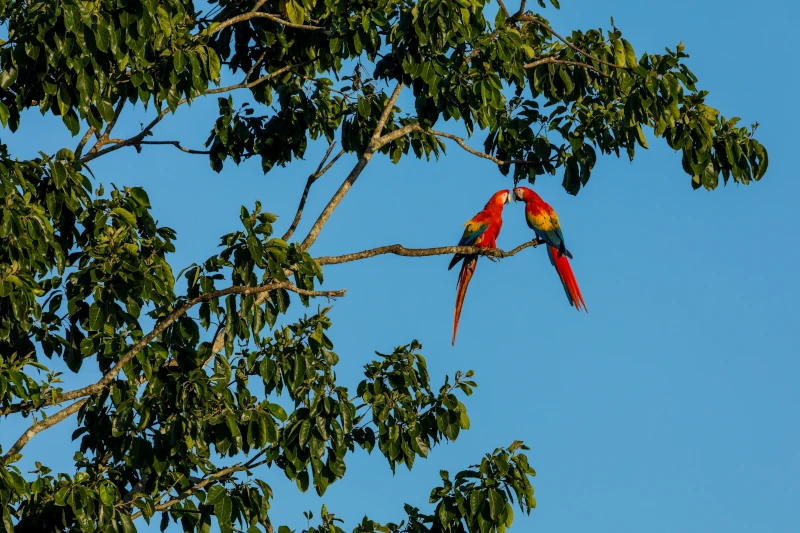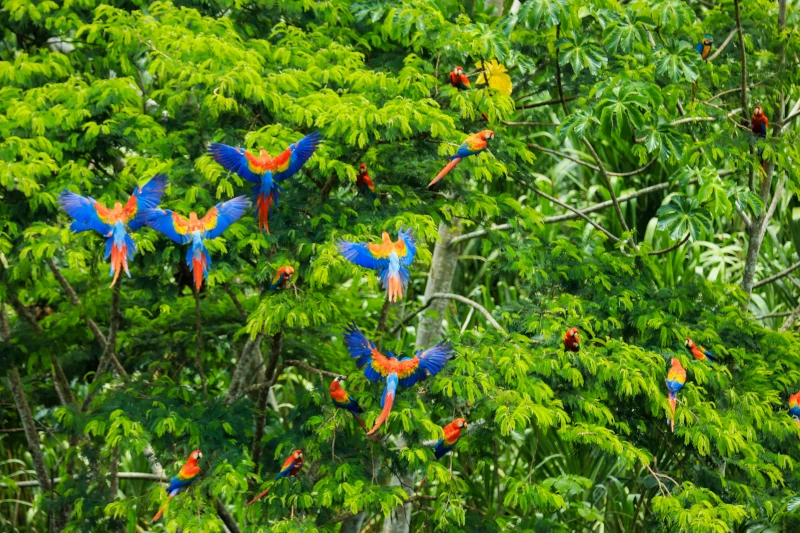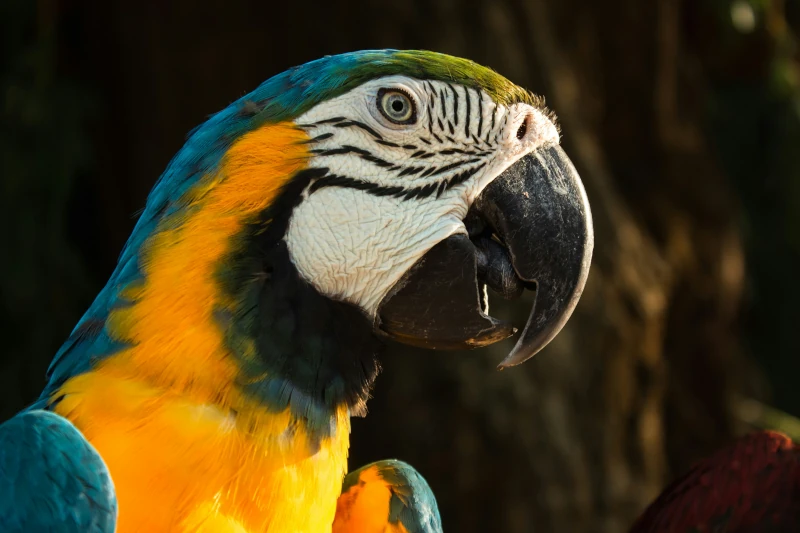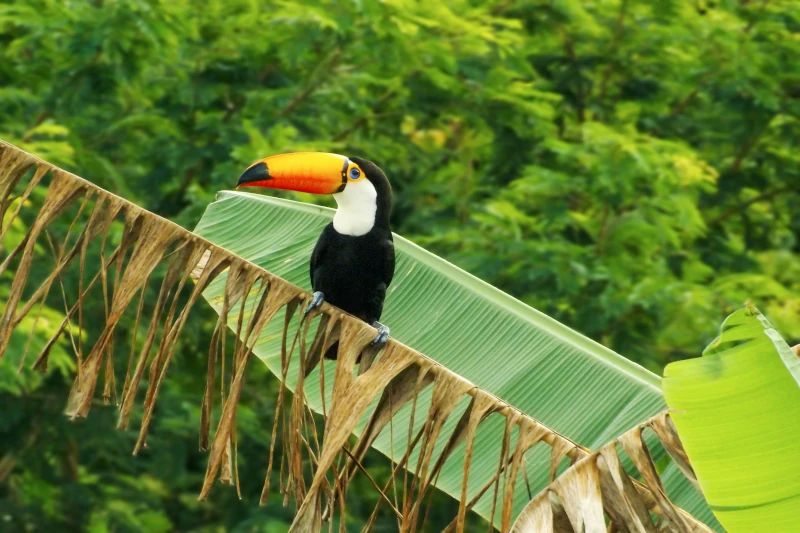When you think about the Amazon rainforest in Peru, what comes to mind? Is it the lush greenery, the winding rivers, or the incredible wildlife? For us, it’s the mesmerizing array of colorful jungle birds that paint this natural wonderland with their vibrant feathers. These birds are more than just visual delights; they play crucial roles in the ecosystem, such as seed dispersal and pollination. Whether you’re a corporate executive seeking a quick escape, a freelance photographer hunting for the perfect shot, or an academic researcher delving into the mysteries of the Amazon, the jungle’s avian inhabitants offer a spectacle worth exploring. The diversity and vibrancy of these birds capture the imagination and provide a glimpse into the interconnectedness of life in this vast rainforest.
The Amazon rainforest is a haven for bird enthusiasts, home to hundreds of tropical bird species, each more striking than the last. This region hosts approximately one-third of the world’s bird species, making it a paradise for ornithologists and nature lovers. The canopy and understory are alive with the sound of chirps, caws, and calls, a symphony of nature that serenades you as you journey through the dense foliage. These sounds are not random; they are part of a complex communication system that includes mating calls, territorial warnings, and social interactions. Each bird species contributes its unique note to the Amazon’s natural orchestra, creating an ever-changing soundtrack that enriches the experience of exploring this biodiverse ecosystem.

One of the most iconic sights in the Peruvian Amazon is the colorful parrots. Known for their intelligence and charm, these birds captivate travelers and locals alike. Parrots are not just pretty faces; they are also known for their ability to mimic sounds, including human speech. The Scarlet Macaw, with its vivid red, blue, and yellow plumage, is a true spectacle. They glide gracefully through the air, often seen in pairs or small flocks. The Blue-and-yellow Macaw is another stunning resident, adding a splash of color to the green backdrop of the jungle. These Amazonian macaws are known for their loud calls, which can be heard echoing through the forest This is a form signaling their presence long before they are seen.
The Amazon is a living palette of exotic bird colors. From the deep greens and iridescent blues to fiery oranges and striking reds, these colors aren’t just for show. These vibrant hues are the result of complex genetic and environmental factors, and they play vital roles in survival and reproduction. They serve various purposes, from attracting mates to camouflaging with the environment. Brightly colored feathers often indicate good health and strong genetics, making them attractive to potential mates. Take the Toucans, for instance, with their oversized bills painted in hues of orange, red, and yellow. These colors help them stand out in the dense forest canopy, a vital trait for social interactions and mating rituals. The toucan’s bill, although large and colorful, is surprisingly lightweight and serves multiple functions, including feeding, and attracting mates.

For those with limited time, planning your itinerary to include the best bird-watching spots is essential. The Amazon basin offers a range of habitats, each supporting a unique assemblage of bird species. The Cock of the rock is one of the most unique species you can spot in this journey. Whether you’re keen on capturing the perfect photograph or simply enjoying the vibrant display, these locations should be at the top of your list. Each of these destinations offers not only incredible birdwatching opportunities but also a chance to connect with nature in its most unspoiled form.
Manu National Park, a UNESCO World Heritage site, is one of the best places to see the colorful jungle birds of South America. Spanning over 1.5 million hectares, the park’s vast expanse encompasses a range of ecosystems, from lowland rainforests to Andean grasslands. With over 1,000 bird species recorded, Manu offers unparalleled opportunities for birdwatching. The park’s remote and relatively untouched cloud forest environments make it a haven for wildlife. Local guides, often with years of experience, can lead you to the best spots and share insights into the behaviors and habits of the birds of Peru.
Tambopata is another hotspot for avian diversity. Its clay licks draw hundreds of parrots and macaws, providing a breathtaking spectacle as these birds gather to feed on the mineral-rich clay. The clay licks are essential for the birds, as the minerals help neutralize toxins. The vibrant display against the clay’s earthy tones is a photographer’s dream come true. Beyond the clay licks, National Reserve of Tambopata has varied habitats, from Aguajales to oxbow lakes. In fact giving a rich tapestry of bird species, each adapted to its niche in the Rainforest ecosystem. Guided top tours in Tambopata often include night excursions, where you can hear the nocturnal calls of owls and other night birds.
Known as the “Jungle of Mirrors” due to its reflective waterways, Pacaya-Samiria offers a unique bird-watching experience. The reserve’s flooded forests and meandering rivers create a dynamic habitat that changes with the seasons, influencing the bird populations you might encounter. The reserve is home to numerous waterbirds, including herons and kingfishers, alongside the colorful jungle birds. Exploring the reserve by canoe allows for a tranquil and immersive experience, where you can observe birds up close without disturbing their natural behaviors. The interplay of light on the water and the surrounding greenery creates stunning visual opportunities for photographers and nature lovers alike.
To maximize your birdwatching experience, planning is key. Research the best times to visit specific locations, as bird activity can vary with seasons and weather conditions. Consider the season, as certain birds are more visible during specific times of the year. The dry season, from May to October, is generally the best time for birdwatching, with clearer skies and easier access to trails. During this time, many birds are breeding, displaying their most vibrant plumage and engaging in fascinating courtship behaviors. It’s also wise to book accommodations and guided tours in advance, as popular birdwatching spots can fill up quickly during peak seasons.
A good pair of binoculars is essential for spotting birds high in the canopy. Choose binoculars with a wide field of view and good light-gathering capabilities to enhance your experience. Additionally, a camera with a zoom lens will help capture the intricate details of these vibrant creatures. Don’t forget a field guide or a bird identification app to enhance your understanding of the species you encounter. Waterproof gear, including boots and rain jackets, is also advisable, as weather conditions in the tropical rainforest can change rapidly. A notebook or digital device to record your observations can enrich your experience and provide a valuable record of your adventure.

While it’s tempting to get as close as possible for that perfect shot, it’s crucial to respect the birds’ natural habitat. Maintain a safe distance, avoid making loud noises, and follow the guidance of local guides to minimize your impact on the environment. Disturbing nesting sites or feeding areas can have detrimental effects on bird populations, so it’s important to prioritize their well-being over capturing an image. Responsible birdwatching in Tambopata ensures that these magnificent creatures continue to thrive in their natural habitats, allowing future generations to enjoy their beauty.
For freelance photographers, the Amazon offers a unique opportunity to capture stunning images that tell a story. The diversity of bird species and their vibrant colors provide endless possibilities for creativity and expression. With the right approach, you can immortalize the vibrant colors and dynamic movements of these jungle birds. Each photograph can serve as a powerful visual narrative, connecting viewers to the wonders of the Amazon.

Lighting can make or break your photograph. The dappled sunlight filtering through the canopy creates dramatic contrasts and highlights the colors of the birds. Understanding how light interacts with the environment can help you anticipate the best times and locations for photography. Early morning and late afternoon are the best times for photography, offering soft, diffused light. These golden hours not only enhance the colors of the birds but also create atmospheric conditions that add depth and emotion to your images.
Pay attention to the composition of your shot. Consider elements such as the rule of thirds, leading lines, and framing to create visually compelling images. Include elements of the jungle, such as branches or leaves, to provide context and depth. Capture the birds in action, whether they’re in flight, feeding, or interacting with one another, to convey a sense of life and motion. Patience is key; sometimes waiting for the right moment can make the difference between a good shot and a great one. Experiment with different angles and perspectives to find unique and captivating compositions.
Beyond the birds, the Amazon is rich in cultural experiences. The region is home to diverse indigenous families, each with its own traditions and way of life. Engaging with local communities can offer insights into the region’s history and traditions. From traditional crafts to culinary delights, the Amazon’s cultural tapestry is as vibrant as its wildlife. Participating in cultural activities not only enriches your understanding of the Amazon but also preserves the Amazon.
Local guides can enhance your understanding of the Amazon’s avian and cultural wealth. Their expertise and knowledge can lead you to hidden gems and lesser-known bird-watching spots, enriching your experience. Guides often share personal stories and insights that provide a deeper connection to the environment and its inhabitants. Building relationships with local guides can also contribute to sustainable tourism, ensuring that your visit benefits the community and the ecosystem.

By choosing eco-friendly lodges and tours, you contribute to the conservation of the Amazon’s unique ecosystem and support the livelihoods of local communities. Sustainable ecotourism practices include minimizing waste, supporting local conservation efforts, and respecting cultural and environmental guidelines. Sustainable tourism ensures that the beauty of the Amazon and its colorful inhabitants can be enjoyed for generations to come. By making conscious choices, you become part of a global effort to protect one of the planet’s most vital and biodiverse regions.
Exploring the colorful jungle birds of the Peru Amazon is an adventure like no other. The journey offers a rare opportunity to connect with nature in its most vibrant and diverse form. Whether you’re seeking a respite from the corporate world, aiming to capture breathtaking photographs, or diving into academic research, the Amazon’s avian wonders offer something for everyone. With careful planning and a respectful approach, your journey into this vibrant world will be both fulfilling and unforgettable. Each encounter with the Amazon’s birds is a reminder of the intricate beauty and complexity of the natural world. Happy birdwatching!